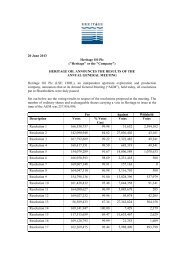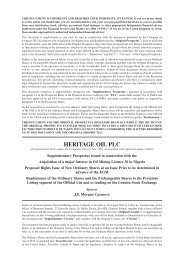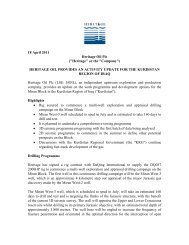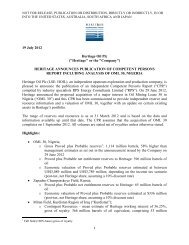Prospectus re Admission to the Official List - Heritage Oil
Prospectus re Admission to the Official List - Heritage Oil
Prospectus re Admission to the Official List - Heritage Oil
You also want an ePaper? Increase the reach of your titles
YUMPU automatically turns print PDFs into web optimized ePapers that Google loves.
RPS Energy<strong>Heritage</strong> <strong>Oil</strong> – Competent Persons Report2.3.2. Prospective Resources (Exploration Prospects)Unlike risk assessment for Contingent Resources, when dealing with undrilled prospects <strong>the</strong><strong>re</strong> is a mo<strong>re</strong>accepted industry approach <strong>to</strong> risk assessment for Prospective Resources. It is standard practice <strong>to</strong> assign aGeological Probability of Success (GPoS) which <strong>re</strong>p<strong>re</strong>sents <strong>the</strong> likelihood of source rock, charge, <strong>re</strong>servoir,trap and seal conspiring <strong>to</strong> <strong>re</strong>sult in a p<strong>re</strong>sent-day hydrocarbon accumulation. RPS assesses risk byconsidering both a Play Risk and a Prospect Risk. The chance of success for <strong>the</strong> Play and Prospect a<strong>re</strong>multiplied <strong>to</strong>ge<strong>the</strong>r <strong>to</strong> give a Geological Probability of Success (GPoS). We consider th<strong>re</strong>e fac<strong>to</strong>rs whenassessing Play Risk: source, <strong>re</strong>servoir, seal and we consider four fac<strong>to</strong>rs when assessing Prospect Risk: trap,seal, <strong>re</strong>servoir and charge. The <strong>re</strong>sult is <strong>the</strong> chance or probability of discovering hydrocarbon volumeswithin <strong>the</strong> range defined (Section 2.4). It is not an estimation of commercial chance of success.2.4. Uncertainty EstimationThe estimation of expected hydrocarbon volumes is an integral part of <strong>the</strong> evaluation process. It is normalpractice <strong>to</strong> assign a range <strong>to</strong> <strong>the</strong> volume estimates because of <strong>the</strong> uncertainty over exactly how large <strong>the</strong>discovery or prospect will be. Estimating <strong>the</strong> range is normally undertaken in a probabilistic way (i.e. usingMonte Carlo simulation), using a range for each input parameter <strong>to</strong> derive a range for <strong>the</strong> output volumes.Key contributing fac<strong>to</strong>rs <strong>to</strong> <strong>the</strong> overall uncertainty a<strong>re</strong> data uncertainty, interp<strong>re</strong>tation uncertainty andmodel uncertainty.Volumetric input parameters, Gross Rock Volume (GRV), porosity, N:G ratio, S w , fluid expansion fac<strong>to</strong>r(Eo or Eg) and <strong>re</strong>covery fac<strong>to</strong>r, a<strong>re</strong> conside<strong>re</strong>d separately. RPS has internal guidelines on <strong>the</strong> best practicein characterising appropriate input distributions for <strong>the</strong>se parameters.Systematic bias in volumetric assessment is a well-established phenomenon. The<strong>re</strong> is a tendency <strong>to</strong>estimate parameters <strong>to</strong> a g<strong>re</strong>ater deg<strong>re</strong>e of p<strong>re</strong>cision than is warranted (2) and <strong>to</strong> bias p<strong>re</strong>-drill estimates <strong>to</strong><strong>the</strong> high side (3) . Rose and Edwards (3) observe <strong>the</strong> tendency <strong>to</strong>wards assessing volumes in <strong>to</strong>o narrow arange, with overly large low-side and mean estimates. RPS uses benchmarked p10/p90 ratios and knownfield-size distributions <strong>to</strong> check <strong>the</strong> <strong>re</strong>asonableness of estimated volumes.3. OMAN BLOCK 83.1. Overview<strong>Heritage</strong> via Eagle Energy (Oman) Ltd holds a 10 per cent. equity in one licence (Block 8) situatedoffsho<strong>re</strong> Oman. This licence was acqui<strong>re</strong>d in 1996 and contains <strong>the</strong> cur<strong>re</strong>ntly producing Bukha Field and<strong>the</strong> undeveloped West Bukha/Henjam discovery.This block is in a <strong>re</strong>gion of complex structu<strong>re</strong>s with a multiphase comp<strong>re</strong>ssional origin. Deformation beganin <strong>the</strong> mid <strong>to</strong> late C<strong>re</strong>taceous with thrust emplacement of <strong>the</strong> Semail ophiolite, followed by salt diapirism,and finally comp<strong>re</strong>ssion and w<strong>re</strong>nching <strong>re</strong>lated <strong>to</strong> <strong>the</strong> mid Miocene Zagross orogeny. The two fields occurin structu<strong>re</strong>s which all have <strong>the</strong> form of anticlines <strong>re</strong>lated <strong>to</strong> backthrusts that probably originated inadvance of <strong>the</strong> Semail ophiolite overthrust, but we<strong>re</strong> modified by continued thrusting and w<strong>re</strong>nch faultmovement in <strong>the</strong> mid Miocene.The <strong>re</strong>servoirs a<strong>re</strong> shelf limes<strong>to</strong>nes of early <strong>to</strong> mid C<strong>re</strong>taceous age. The Aptian age Thamama Grouplimes<strong>to</strong>nes a<strong>re</strong> sealed by Albian Nahr Umr Formation shales. These units a<strong>re</strong> followed by a fur<strong>the</strong>r seriesof shelf limes<strong>to</strong>nes of late Albian <strong>to</strong> Cenomanian age: termed <strong>the</strong> Mauddud, Khatiyah and Mishrif(=Sarvak in Iran) Formations. Deposition of <strong>the</strong>se units was <strong>the</strong>n followed by <strong>the</strong> major 92Ma (Turonian)unconformity, which is <strong>re</strong>lated <strong>to</strong> <strong>the</strong> emplacement of <strong>the</strong> Semail Ophiolite. The extent and depth of thisunconformity inc<strong>re</strong>ases <strong>to</strong>wards <strong>the</strong> main thrust front in onsho<strong>re</strong> Oman (hence <strong>the</strong> younger <strong>re</strong>servoirs a<strong>re</strong>missing in <strong>the</strong> Bukha a<strong>re</strong>as <strong>to</strong>wards <strong>the</strong> west). This erosive phase was followed, firstly by <strong>the</strong> transg<strong>re</strong>ssiveLaffan shale, and <strong>the</strong>n by <strong>the</strong> shallow water carbonate Ilam Formation. Both formations a<strong>re</strong> ofConiacian-San<strong>to</strong>nian age.Late C<strong>re</strong>taceous sedimentation was in a fo<strong>re</strong>deep west of <strong>the</strong> thrust front, in which <strong>the</strong> Aruma Groupflysch was deposited. Phases of structural growth continued in <strong>the</strong> Palaeocene, Oligocene and LateMiocene. The Miocene unconformity is particularly strongly developed, and is locally highly angularshowing that most structural growth was just p<strong>re</strong> late Miocene.(2) Rose, P.R., 1987. Dealing with Risk and Uncertainty in Exploration: How Can We Improve? AAPG Bulletin, 71 (1), pp. 1-16.(3) Rose, R.P. and Edwards, B., 2001. Could this prospect turn out <strong>to</strong> be a medioc<strong>re</strong> little one-well field? Abstract, AAPGBulletin, 84(13)78















